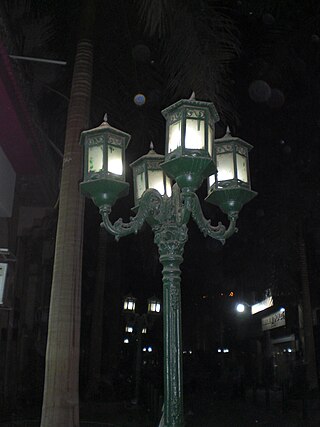The American University in Cairo is a private research university in Cairo, Egypt. The university offers American-style learning programs at undergraduate, graduate, and professional levels, along with a continuing education program.

Heliopolis was an early 20th Century suburb outside Cairo, Egypt, which has since merged with Cairo and is administratively divided into the districts of Masr El Gedida and El Nozha in the Eastern Area.

The Headquarters of the Arab League is located in Tahrir Square and near the downtown business district of Cairo, Egypt. The headquarters building has views of the Nile River and Qasr al-Nil Bridge just to the west.

Kasr AL Ainy Hospital is a research and teaching hospital in Cairo, Egypt. This hospital is affiliated with the Kasr AL Ainy Faculty of Medicine, Cairo University and was founded on March 11, 1827.

There have been many architectural styles used in Egyptian buildings over the centuries, including Ancient Egyptian architecture, Greco-Roman architecture, Islamic architecture, and modern architecture.

Tahrir Square, also known as "Martyr Square", is a major public town square in downtown Cairo, Egypt. The square has been the location and focus for political demonstrations. The 2011 Egyptian revolution and the resignation of President Hosni Mubarak occurred at the Tahrir Square.

The Qasr el Nil Bridge, is a historic swing bridge structure dating from 1931 which replaced the first bridge to span the Nile River in central Cairo, Egypt. It connects Tahrir Square in Downtown Cairo on the east bank of the river, to the southern end of Gezira/Zamalek Island. At the bridge's east and west approaches are four large bronze lion statues; they are late 19th-century works by Henri Alfred Jacquemart, French sculptor and animalier.

The American University in Cairo Press is the leading English-language publisher in the Middle East.

Downtown Cairo is the colloquial name given to the 19th-century western expansion of Egypt's capital Cairo, between the historic medieval Cairo, and the Nile, which became the commercial center of the city during the 20th century. Given its rich architectural heritage from the era of Khedive Ismail, it is has been officially named Khedival Cairo and declared by the government as a protected Area of Value, with many of its buildings also deemed protected. Administratively Wust al-Balad covers areas of qism Qasr al-Nil, and the Abdeen and Ezbekia districts. The protected Khedival Cairo covers a larger area extending south to Sayida Zeinab.

Qasr Eleini Street or Asr Eleini Street by Egyptian pronunciation (Egyptian Arabic: شارع قصر العينى is translated as is one of the oldest streets in downtown Cairo, Egypt.

Qasr El Nil Street, is a street in downtown Cairo, Egypt, one of the biggest streets in Cairo, with many businesses, restaurants, and an active nightlife.

Talaat Harb Street is a historic street in downtown Cairo, Egypt, connecting Tahrir Square and Talaat Harb Square.

Garden City is an early 20th Century real estate development loosely based on the English garden city movement, and is today a mixed residential and administrative quarter in qism Qasr al-Nil in the West District of Cairo, Egypt. It spans the east side of the Nile just south of Wust al-Balad (downtown) and the famous Midan Tahrir, and north of Old Cairo. Two main streets, Qasr al-Ayni Street on the east and the Nile Corniche on the west, delineate its eastern and western borders. Garden City is known for its quiet, upscale, and secure atmosphere. The United States, British, Italian and more Embassies are located there.

Mogamma el Tahrir is a government building in Cairo, Egypt. The Mogamma was the result of a series of master plans for Esamailiyya Square, which used to be occupied by the British barracks. In 1945 when King Farouk ordered the demolition of the barracks upon the departure of British troops from the area, a series of urban planning proposals ensued. The idea for a centralised, all-in-one administrative building emerged from the 1945 plans. Construction began in 1946, and ended in 1949. The building's style reflects typical 1940s modernism, and government buildings in the same style can be found in Buffalo, New York, and Paris. Contrary to popular belief, there is no Soviet association or inspiration, and the building was not constructed by the government of Egypt's second President, Gamal Abdel Nasser. Indeed, Nasser did not become the leader of Egypt until November 1954, several years after the building was completed.

AUC Libraries and Learning Technologies(LLT) is a school of the American University in Cairo. It is located on the University’s New Campus, in New Cairo, Egypt.

The GrEEK Campus, also GEEK Campus, is a technology and innovation park in Cairo, Egypt. The campus provides workspaces for rent, for startups, as well as established local and multinational companies. Located in Downtown Cairo, The GrEEK Campus consists of five office buildings with a total space of 25,000 m2.

The following outline is provided as an overview of and topical guide to Cairo:
Sahar Saleem is a professor of radiology at Cairo University where she specialises in paleoradiology, the use of radiology to study mummies. She discovered the knife wound in the throat of Ramesses III, which was most likely the cause of his death.

The Immobilia Building is considered Cairo´s First Skyscraper. It is located in Downtown Cairo, the urban center of Cairo, at the intersection of Qasr el-Nile and Sherif streets. With a surface area of 5,444 square meters, it remains one of the biggest buildings in the Downtown area to date.


















